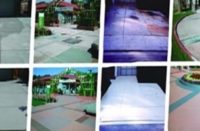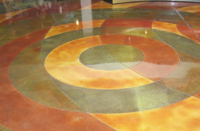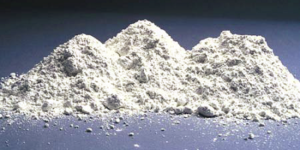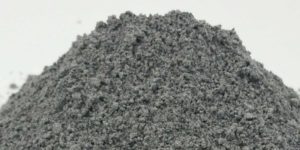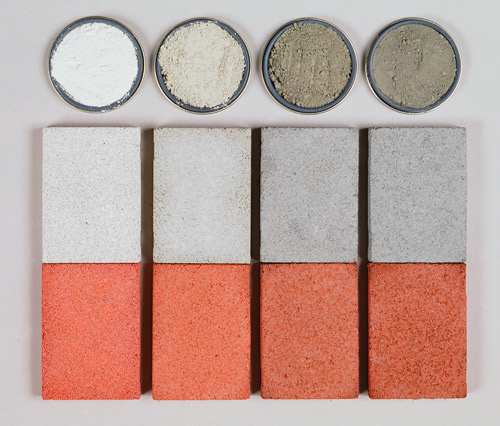
In most cases, concrete made from standard gray portland cement will do the job nicely. But sometimes, especially when a pastel color takes precedence in the overall picture, decorative concrete contractors need to think outside the gray.
“There are brights and lights that just can’t be hit with gray cement,” says Greg Iannone, sales manager for Innotech Decorative Concrete Products.
Luckily, there are alternatives to help decorative concrete professionals achieve pastels and deeply saturated colors, he says. They just need to be thought out in advance.
For one, there’s white ready-mix concrete. Other options include stampable overlays, microtoppings and color hardeners made with white cement, Iannone says. Which one to choose largely depends on the individual job.

White-brightened concrete
The American Concrete Institute’s working draft of ACI 310R, its new Guide to Decorative Concrete, singles out white cement as a color aid: “White cement is a good choice when developing a colored concrete in applications where the need for color consistency is high, where the color is more difficult to achieve, or to reduce the amount of pigment added to the mixture.”
Contractors who deal with high-end architecture and other projects where colors need to be the same from one batch to the next also turn to white-cement concrete as part of their solution.
According to Byron A. Klemaske II, executive vice president of operations for T.B. Penick & Sons Inc., “We use white as well as Type III cement, which is sometimes referred to as poor man’s white,” although he doesn’t know why because the latter is still pretty spendy.
“White and Type III give you a much broader palette of colors. When working with integral color you get lighter and brighter colors with a lower dosage,” he says. “You can also achieve a look similar to what dry-shake color hardener will give you.”
“Companies specializing in color use white cement,” says Larry Rowland, manager of marketing and technical services for Lehigh White Cement Co. “People will use white portland (and a colorant) to make concrete in gray color tones. If they used standard gray portland it would be difficult to color-match. They pay for color consistency.”
Rowland says companies including L. M. Scofield Co., Raeco Inc., Laticrete International Inc. and Mapei Corp. use white cement in their preblended cementitious products.
With repair work, white cement can be helpful since patching mixes usually call for double the amount of cement per volume. “You can mix white cement with your standard gray so when it cures the patch will be lighter and blend in better with the background color,” Rowland says.
Contrary to popular belief, white ready-mix concrete is available throughout the country. “It’s more common than most people think,” he says, adding that white ready-mix has been used to build churches as intricate as Cathedral of Our Lady of the Angels, in Los Angeles, and stores as ordinary as those in the WinCo Foods chain.
“We’re able to get our local ready-mix companies to work with us,” Klemaske says. “It just takes some coordination and planning since they have to dedicate silos for us.”
Rowland notes there may be an availability issue in some places for ready-mix white concrete, a situation he hopes will be remedied once ready-mix suppliers realize white concrete can deliver greater profit than gray.
“It’s an incredible product to work with,” Klemaske says.

Another option to help you achieve bright pastel colors is using one of the white cement-based overlays available today, says Paul Koury, president of Westcoat Specialty Coating Systems.
Westcoat TC-25, his company’s self-leveling cementitious white overlay applied at about 1/4 inch, can be tinted with as little as a half ounce of liquid colorant per 50 pounds of mixture for a natural, soft look. “The beautiful thing is you can get light buff colors — light tan, pink or sky blue — using integral colorants. Or you can add up to 8 ounces to get a brighter color,” Koury says. Regardless of the dose, “The colors won’t be muddied.”
An acid or solvent-based stain also can be applied atop a white overlay to achieve vibrant colors, Koury says, but integral coloring is his favorite. “The outcome will be more subtle, more natural looking, versus putting the color on top of the overlay,” he says. “You can dilute and thin the stain and put it down very lightly, but that’s harder to control. I like the stains for accenting the integrally colored cement.”Not to mention, he continues, “It costs less money to tint integrally.” You not only save money in coloring products but you save on labor. “There’s one less step involved in the process. You can get in and out quicker.”

Toppings and color hardeners
In addition to stampable overlays, white microtoppings — which produce a very thin overlay no thicker than a credit card — can be used to achieve pastels and very bright colors. They come as a bagged powder product that mixes with a liquid polymer, says Iannone. “When mixed together it comes out in a pancake batter consistency and is applied with a tapered squeegee to leave a thin coating on the surface.”
Iannone says Innotech can precolor the powder to match a Pantone color chip for a custom blend. “There are minimal order requirements,” he says. Custom-colored microtoppings can be expensive, he adds, but less expensive than ready-mix white cement concrete.
“You also have more control with a microtopping versus ready-mix white cement (concrete),” he says. “The color is consistent throughout and is the same batch after batch,” whereas there can be detectable color or shade differences from truckload to truckload of white or even gray concrete. “There are a lot of variables that affect the ultimate color of the ready-mix product,” including slump, consistency from truck to truck and time of day poured.
Another product that can be applied to lighten a concrete surface is a color hardener that includes white cement as one of its ingredients, Iannone says. Because it is a topical application and not an integral color, “You can apply additional color hardener as needed during the placement and finishing process to achieve the desired color you want.”
Expect to use more color hardener to overcome the gray concrete, he says, when you are trying to achieve a lighter color.
Iannone notes titanium dioxide can also be used as a white pigment additive to make concrete whiter and brighter. “But it’s very expensive,” he says. He recommends methods involving white cement instead.
www.innotechdcp.com
www.westcoat.com
